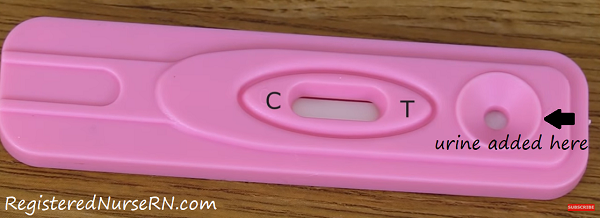How to take or administer a pregnancy test review for nurses!
As a nurse you may be required to collect and interpret a pregnancy test. This review will help you understand what a pregnancy test measures, how to administer a test, and what a negative or positive result looks like.
Demonstration on How to Take or Administer a Pregnancy Test
Pregnancy Test
 Why would a pregnancy test be ordered in a clinical setting? There are various reasons for why a pregnancy test would be ordered. The most common reason is because a woman believes she may be pregnant. However, many times a pregnancy test is ordered before certain procedures, administration of particular types of medications, or before any other type of health service is provided to a woman who is within childbearing age/sexually active. Most commonly this test is performed in the emergency room or as pre-operative protocol.
Why would a pregnancy test be ordered in a clinical setting? There are various reasons for why a pregnancy test would be ordered. The most common reason is because a woman believes she may be pregnant. However, many times a pregnancy test is ordered before certain procedures, administration of particular types of medications, or before any other type of health service is provided to a woman who is within childbearing age/sexually active. Most commonly this test is performed in the emergency room or as pre-operative protocol.
What does a pregnancy test measure? It detects hCG in the urine.
What’s hCG? hCG stands for human chorionic gonadotropin. This is a hormone that is secreted by the placenta. This hormone can be found in the blood and urine. If hCG is present in the urine it could indicate that an egg was released during ovulation and was successfully fertilized by a sperm. Then the fertilized egg traveled down into the uterus and attached (or implanted) itself within the lining of the uterus. Therefore, a baby is growing in the uterus.
When is it best to take a pregnancy test?
The best time to take a pregnancy test is when you’ve missed your scheduled period. In addition, it is best to take the test in the morning when the urine is most concentrated.
NOTE: Always read the manufacture’s directions for the test. There are many different brands of pregnancy tests on the market. Some advertise they can detect hCG in the urine days before your next scheduled period. In addition, each test is different in how they require you to add the urine sample to the test. This review will use a basic pregnancy test that requires you to use a dropper to add the urine to the test.
What supplies do you need to take a pregnancy test?
- Disposable cup to catch your urine
- Pregnancy test (always follow the instructions with the test)
- Timer (phone timer or watch)
- Gloves in a clinical setting when administering a test to protect you from the patient’s urine
Important things to know about the test:
Most pregnancy tests have an area that is labeled with a T and C. T stands for test, and this is where the test result will display (hence the appearance of a line, which means the test is positive). C stands for control, and a line should pop up in this area, which is a good thing because it tells you that enough urine was added to the test and the test is working. In addition, there is an area where the urine sample is added (read instructions for details because this varies on test brands).
As noted above pregnancy tests are different depending on the manufacture. For some tests you urinate directly on an area on the test (hence you’ve probably heard that phrase “pee on a stick”). Or you dip a part of the test into the urine collection cup for several seconds, or you use a pipette or dropper to remove urine and place it on the test, which is how this test will work for this review.
Steps on How to Take a Pregnancy Test
- Wash your hands
- Urinate in a disposable cup….if in a clinical setting wash hands and don gloves before touching the urine sample
- Wash your hands again
- Use the provided dropper to remove some urine from the sample
- Drop the required amount of urine onto the test area (3 drops were added for this test)

- Keep the test on a flat surface
- Wait for results by setting a timer (this test says to wait 3 minutes to read results and results are NOT valid after 5 minutes)
- Interpret results (read the instructions)
- This test interpretation:

- Positive: Two lines (one line in the test area and one line in the control area)…the test detected hCG in the urine
- Negative: One line (one line in the control area BUT NO line in the test area)…the test did NOT detect hCG in the urine
- Remove gloves if worn and wash hands
- This test interpretation:
If you have a positive result: make an appointment with your doctor and let them know you had a positive home pregnancy test. They will confirm it and provide care from there.
If you have a negative result: wait to see if your period starts…if it doesn’t re-test…you may have tested too early…if still negative and you don’t get your period make an appointment with you doctor.
You may be interested in more Maternity Nursing Reviews.
References: